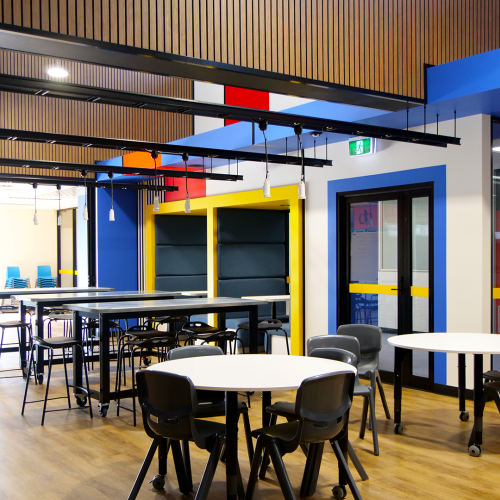Purruna Spencer Newton Centre, Scotch College
- Client:
- Scotch College Adelaide
- Location:
- Torrens Park, South Australia
- Features:
- + 25 metre swimming pool and separate beginners pool
+ Two indoor multi-purpose courts
+ Flexible classroom and collaboration spaces that can be used for a range of physical, wellbeing and spiritual activities including meditation, yoga, mindfulness, reflection, teaching and dance
+ A collaborative workspace for pastoral care leaders and allied health professionals to support the school community
+ Modular contemporary student spaces, teacher facilities and offices
+ Outdoor teaching and gathering area - Awards:
-
AIA SA Architecture Awards - The Dr John Mayfield Award for Educational Architecture - 2024
AIA SA Architecture Awards - Sustainable Architecture Award - 2024
Learning Environments Australasia SA & NT Chapter Awards - Category 1: An Innovative Education Initiative Commendation - 2024
- Credits:
-
Caillin Howard
Yaara Plaves
Roberto Garcia
- Project Website:
- Visit the project's website
Purruna Spencer Newton Centre sets a new benchmark for holistic wellness and sustainable development, and is a testament to Scotch College’s commitment to making the future a better place, not just for its students but the wider community.
The new Wellbeing and Sports Centre is the largest building project in Scotch College’s hundred-year history, located at their Torrens Park Campus on the site of the former gym and pool that were deemed no longer fit for purpose.
Hames Sharley, in conjunction with Scotch College, developed a very strong vision for the Centre – aspiring to ‘replace the old with the bold’ and to provide the infrastructure for the College to deliver its ‘Live Well’ program. Live Well aims to de-silo key faculties. Similarly, the project scope extends beyond the site boundary, through industry collaboration, community participation and holistic design approach.
The conceptual framework for the project was identified through an exhaustive 18-month consultation process which defined the project’s aspirations and distilled our understanding of what ‘wellbeing’ looks like. These were translated into design principles to provide the guiding framework to bring the building to fruition and achieve the core aim of building a connection between students, families, and the broader community through the platform of wellbeing.

Integrating the Centre with the Scotch College campus was a strategic endeavour to publicly and culturally benefit local communities and the school itself.
With ‘wellbeing’ at the heart of the project, it was important that the context of the new building was respectful to the surrounding residential houses and prominent in the pre-existing school campus. The building acts as the new focal point and hub of the school, reflecting physical, symbolic and spiritual axes on-site with stunning views of the campus and the city.
True to the spirit of ‘wellbeing’, the Centre was designed to surpass sustainable design, aiming for regenerative design. The project restored the site, improved habitat, encourages active transport and EV, reduced embodied and operational carbon, minimised water use, improved indoor air quality, and used biophilic design to improve wellbeing.











